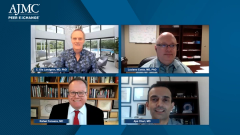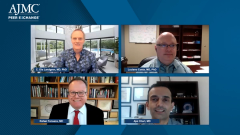
The Role of Venetoclax in R/R Multiple Myeloma
Key opinion leaders consider the role of venetoclax in managing patients with relapsed/refractory multiple myeloma.
Episodes in this series

C. Ola Landgren, MD, PhD: I’m going to switch gears from these antibodies. Luciano, we saw venetoclax in Lancet Oncology from the BELLINI study; venetoclax vs Velcade-DEX [bortezomib, dexamethasone] vs Velcade-Dex [bortezomib, dexamethasone] had a much better depth of response because there was a better PFS [progression-free survival].
Then the OS [overall survival] was flipped, and the data were dissected. We have known this for a long time. It’s been discussed among us and others. The excess death in the venetoclax group was in patients without 11, 14 translocation. We still don’t know what’s really going on, but is this a good drug? What do you think?
Luciano Costa, MD, PhD: It’s a fantastic drug on the right patients. We’re not going to dive into BELLINI again; that’s a painful exercise. It’s extremely rare to see a drug where 1 arm outperforms in the PFS and then loses in the OS. Suddenly you have the best Vd [bortezomib, dexamethasone] control arm in any clinical trial by a large margin. I suspect those people are progressing and going on to get DARA [daratumumab] combination and another trial, but there is no proof of that. DARA [daratumumab] is becoming very clear. It became more clear in BELLINI despite the small numbers. There is a penalty of adding any third agent. Certainly there is a penalty for adding venetoclax in terms of toxicity. We’re still trying to understand some of that. I am surprised it didn’t come out in other diseases where venetoclax has a much more established role; perhaps because the mortality is so high. For example, with chemotherapy in MDS [myelodysplastic syndrome], that edge in efficacy easily overcomes that.
It’s clear that the magnitude of the benefit of 11,14 in BELLINI was like a 90 percent reduction in risk of progression. That’s unheard of for any agent in any setting for myeloma. Of course, then it needs to be replicated, and it’s become firm in that specific population in other trials. It’s a bit of a novelty for us because we develop treatments for myeloma. Every approach we have taken for myeloma so far, every drug we have developed, is for all…. It’s a challenge to see how well we’re going to be able to as a community develop these drugs in 1 particular subset.
Among patients with 11,14, [daratumumab is] likely to be the most active agent. I suspect it enhances responses, even in non–11,14 patients. We presented a enough long-term data that venetoclax-carfilzomib–DARA [daratumumab] and carfilzomib–DEX [dexamethasone] at this meeting where the response rate looks great; even for 11,14 negative. We’re probably never going to go down that path again. It’s too crowded of a field, and I don’t think anybody wants to develop it even in non–11,14 patients. For those patients, I’m among those who would use venetoclax as early as needed, given the magnitude of the impact.
C. Ola Landgren, MD, PhD: I’ll put you on the spot here. Say a patient who has been treated with your favorite therapy, DARA-KRd [daratumumab, carfilzomib, lenalidomide, dexamethasone], and you have transplanted a patient. You put this patient on additional cycles with MRD [minimal residue disease] follow-up of several years of chemotherapy in your clinic. This was on 11,14 translocated patient. Unfortunately have only 2 drug combinations to choose between. It could be carfilzomib-venetoclax–DEX [dexamethasone]—this is 6 years later—or DARA-carfilzomib-DEX [daratumumab, carfilzomib, dexamethasone]. What do you think?
Luciano Costa, MD, PhD: That’s a good question. We don’t know the answer. If I had to make the decision today, I’ll probably use carfilzomib–DARA [daratumumab] because it’s a more defensible approach. I suspect the impact of adding venetoclax to K [carfilzomib] is going to be greater than the effect of adding daratumumab to K [carfilzomib] in 11,14 patients. But there are very little data to support that.
C. Ola Landgren, MD, PhD: I know that was not a randomized study, so I was just trying to be a little difficult with you.
Newsletter
Stay ahead of policy, cost, and value—subscribe to AJMC for expert insights at the intersection of clinical care and health economics.









































